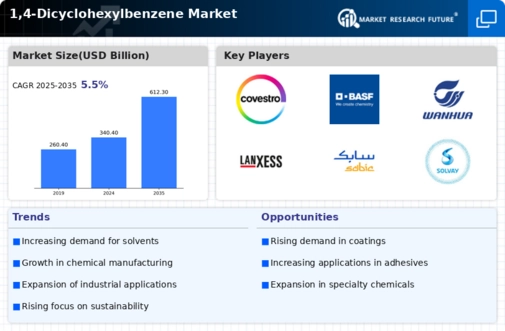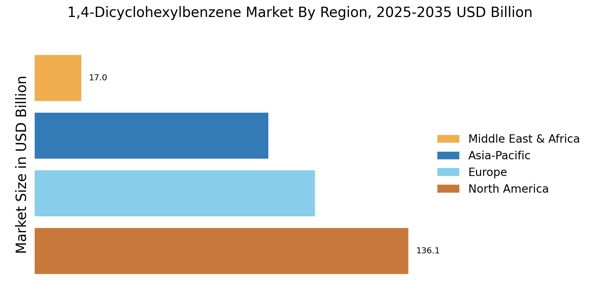Expansion of End-Use Industries
The 1,4-Dicyclohexylbenzene Market is significantly influenced by the expansion of end-use industries such as automotive, electronics, and construction. These sectors utilize 1,4-Dicyclohexylbenzene for its excellent thermal stability and chemical resistance. For instance, in the automotive industry, the compound is employed in the production of high-performance adhesives and sealants. As these industries continue to grow, driven by technological advancements and increasing consumer demand, the requirement for 1,4-Dicyclohexylbenzene is expected to rise. Market analysis suggests that the automotive sector alone is anticipated to witness a growth rate of around 5% annually, further bolstering the 1,4-Dicyclohexylbenzene Market.
Innovations in Product Applications
Innovations in product applications are playing a pivotal role in shaping the 1,4-Dicyclohexylbenzene Market. The compound is increasingly being explored for new applications, particularly in the field of advanced materials and specialty chemicals. Research indicates that the development of high-performance coatings and adhesives utilizing 1,4-Dicyclohexylbenzene is gaining traction. This trend is likely to enhance the compound's market appeal, as manufacturers seek to differentiate their products in a competitive landscape. Furthermore, the introduction of novel formulations that leverage the unique properties of 1,4-Dicyclohexylbenzene could potentially open new avenues for growth within the market.
Rising Demand in Chemical Manufacturing
The 1,4-Dicyclohexylbenzene Market is experiencing a notable increase in demand due to its applications in chemical manufacturing. This compound serves as a crucial intermediate in the production of various chemicals, including resins and polymers. As industries seek to enhance product performance and durability, the need for high-quality intermediates like 1,4-Dicyclohexylbenzene is likely to grow. Recent data indicates that the chemical manufacturing sector is projected to expand at a compound annual growth rate (CAGR) of approximately 4.5% over the next five years. This growth is expected to drive the demand for 1,4-Dicyclohexylbenzene, thereby positively impacting the market dynamics.
Increasing Focus on Sustainable Practices
The 1,4-Dicyclohexylbenzene Market is witnessing a shift towards sustainable practices, driven by growing environmental concerns. Manufacturers are increasingly adopting eco-friendly production methods and sourcing raw materials responsibly. This trend is not only aligned with regulatory requirements but also caters to the rising consumer preference for sustainable products. As companies strive to reduce their carbon footprint, the demand for sustainable alternatives in the chemical sector is likely to increase. Consequently, the 1,4-Dicyclohexylbenzene Market may benefit from this transition, as stakeholders seek to align their operations with sustainability goals.
Regulatory Compliance and Safety Standards
Regulatory compliance and safety standards are becoming increasingly stringent within the 1,4-Dicyclohexylbenzene Market. Governments and regulatory bodies are implementing more rigorous guidelines to ensure the safe handling and use of chemical substances. This trend necessitates that manufacturers invest in compliance measures and safety protocols, which could influence production costs. However, adherence to these regulations may also enhance product credibility and market acceptance. As industries prioritize safety and compliance, the demand for 1,4-Dicyclohexylbenzene, which meets these standards, is likely to see a positive impact, thereby shaping the market landscape.


















Leave a Comment